Taxation Law: CGT, Deductions, and Exemptions - Student ID [Date]
VerifiedAdded on 2023/06/03
|7
|1675
|204
Homework Assignment
AI Summary
This assignment provides a detailed analysis of Capital Gains Tax (CGT) implications and permissible deductions under Australian Taxation Law. It examines the applicability of CGT on the sale of a duplex, differentiating between the portion used as the main residence and the investment portion, leveraging provisions like subdivision 118-B ITAA 1997 for main residence exemptions. The document further explores the deductibility of various expenses, including pre-purchase costs, ownership costs, and repair costs, referencing relevant sections of ITAA 1997 and tax rulings. Computations are presented to determine capital gains on the duplex, painting, and Ming vase, factoring in cost base elements and applicable discounts. The analysis concludes with the calculation of the net CGT liability for the taxpayer and a recommendation based on the findings, highlighting that Desklib provides past papers and solved assignments for students.
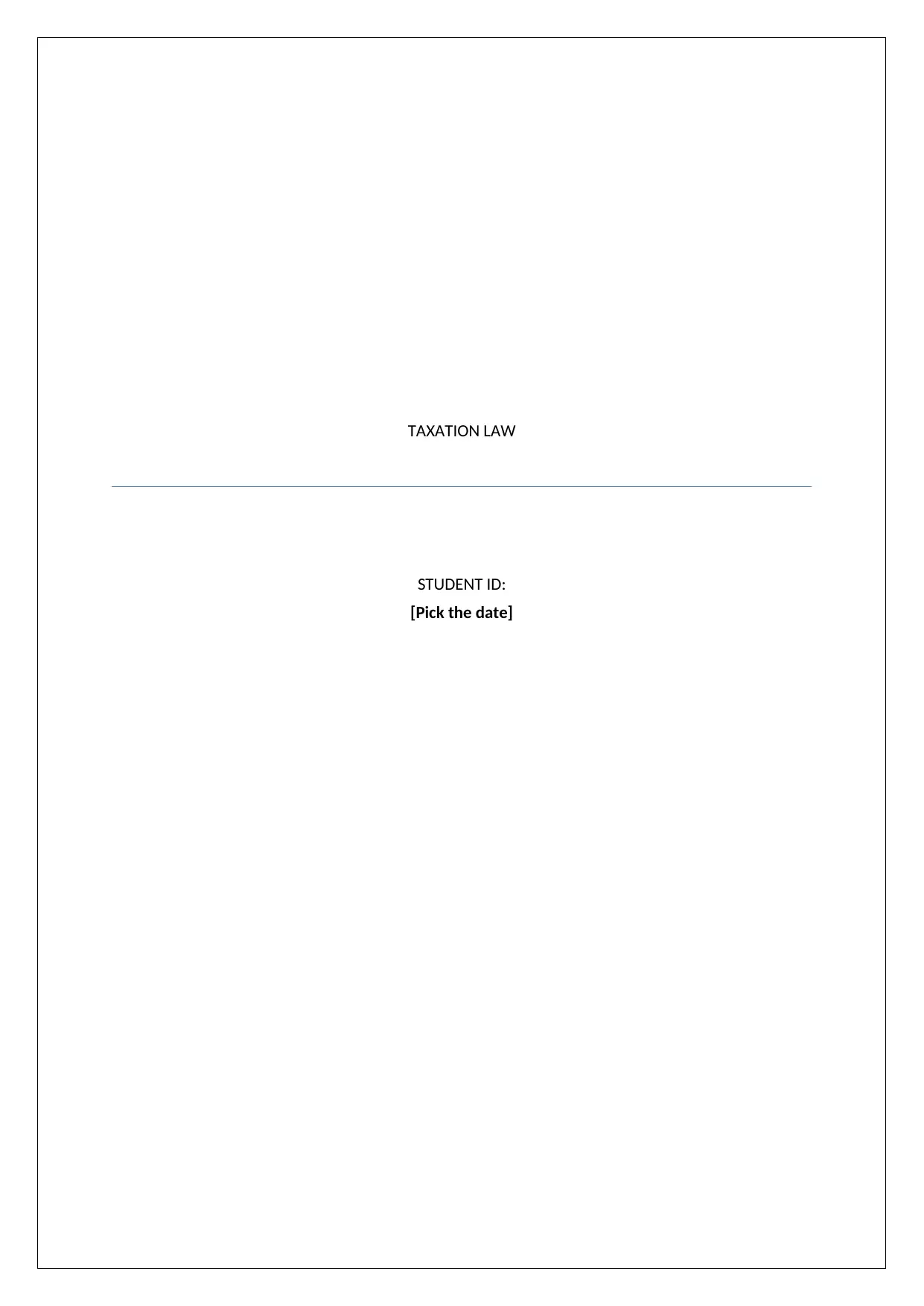
TAXATION LAW
STUDENT ID:
[Pick the date]
STUDENT ID:
[Pick the date]
Paraphrase This Document
Need a fresh take? Get an instant paraphrase of this document with our AI Paraphraser
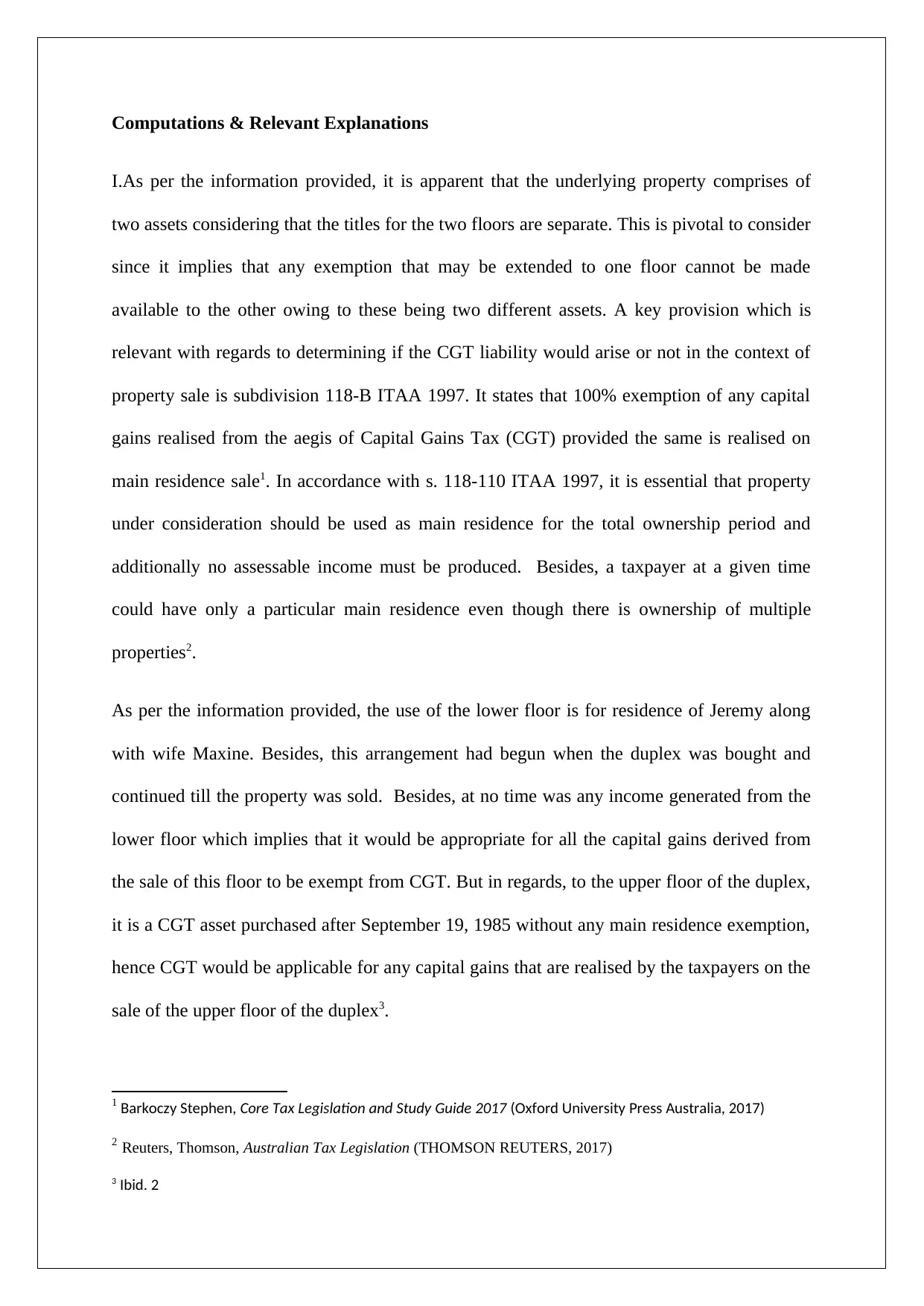
Computations & Relevant Explanations
I.As per the information provided, it is apparent that the underlying property comprises of
two assets considering that the titles for the two floors are separate. This is pivotal to consider
since it implies that any exemption that may be extended to one floor cannot be made
available to the other owing to these being two different assets. A key provision which is
relevant with regards to determining if the CGT liability would arise or not in the context of
property sale is subdivision 118-B ITAA 1997. It states that 100% exemption of any capital
gains realised from the aegis of Capital Gains Tax (CGT) provided the same is realised on
main residence sale1. In accordance with s. 118-110 ITAA 1997, it is essential that property
under consideration should be used as main residence for the total ownership period and
additionally no assessable income must be produced. Besides, a taxpayer at a given time
could have only a particular main residence even though there is ownership of multiple
properties2.
As per the information provided, the use of the lower floor is for residence of Jeremy along
with wife Maxine. Besides, this arrangement had begun when the duplex was bought and
continued till the property was sold. Besides, at no time was any income generated from the
lower floor which implies that it would be appropriate for all the capital gains derived from
the sale of this floor to be exempt from CGT. But in regards, to the upper floor of the duplex,
it is a CGT asset purchased after September 19, 1985 without any main residence exemption,
hence CGT would be applicable for any capital gains that are realised by the taxpayers on the
sale of the upper floor of the duplex3.
1 Barkoczy Stephen, Core Tax Legislation and Study Guide 2017 (Oxford University Press Australia, 2017)
2 Reuters, Thomson, Australian Tax Legislation (THOMSON REUTERS, 2017)
3 Ibid. 2
I.As per the information provided, it is apparent that the underlying property comprises of
two assets considering that the titles for the two floors are separate. This is pivotal to consider
since it implies that any exemption that may be extended to one floor cannot be made
available to the other owing to these being two different assets. A key provision which is
relevant with regards to determining if the CGT liability would arise or not in the context of
property sale is subdivision 118-B ITAA 1997. It states that 100% exemption of any capital
gains realised from the aegis of Capital Gains Tax (CGT) provided the same is realised on
main residence sale1. In accordance with s. 118-110 ITAA 1997, it is essential that property
under consideration should be used as main residence for the total ownership period and
additionally no assessable income must be produced. Besides, a taxpayer at a given time
could have only a particular main residence even though there is ownership of multiple
properties2.
As per the information provided, the use of the lower floor is for residence of Jeremy along
with wife Maxine. Besides, this arrangement had begun when the duplex was bought and
continued till the property was sold. Besides, at no time was any income generated from the
lower floor which implies that it would be appropriate for all the capital gains derived from
the sale of this floor to be exempt from CGT. But in regards, to the upper floor of the duplex,
it is a CGT asset purchased after September 19, 1985 without any main residence exemption,
hence CGT would be applicable for any capital gains that are realised by the taxpayers on the
sale of the upper floor of the duplex3.
1 Barkoczy Stephen, Core Tax Legislation and Study Guide 2017 (Oxford University Press Australia, 2017)
2 Reuters, Thomson, Australian Tax Legislation (THOMSON REUTERS, 2017)
3 Ibid. 2
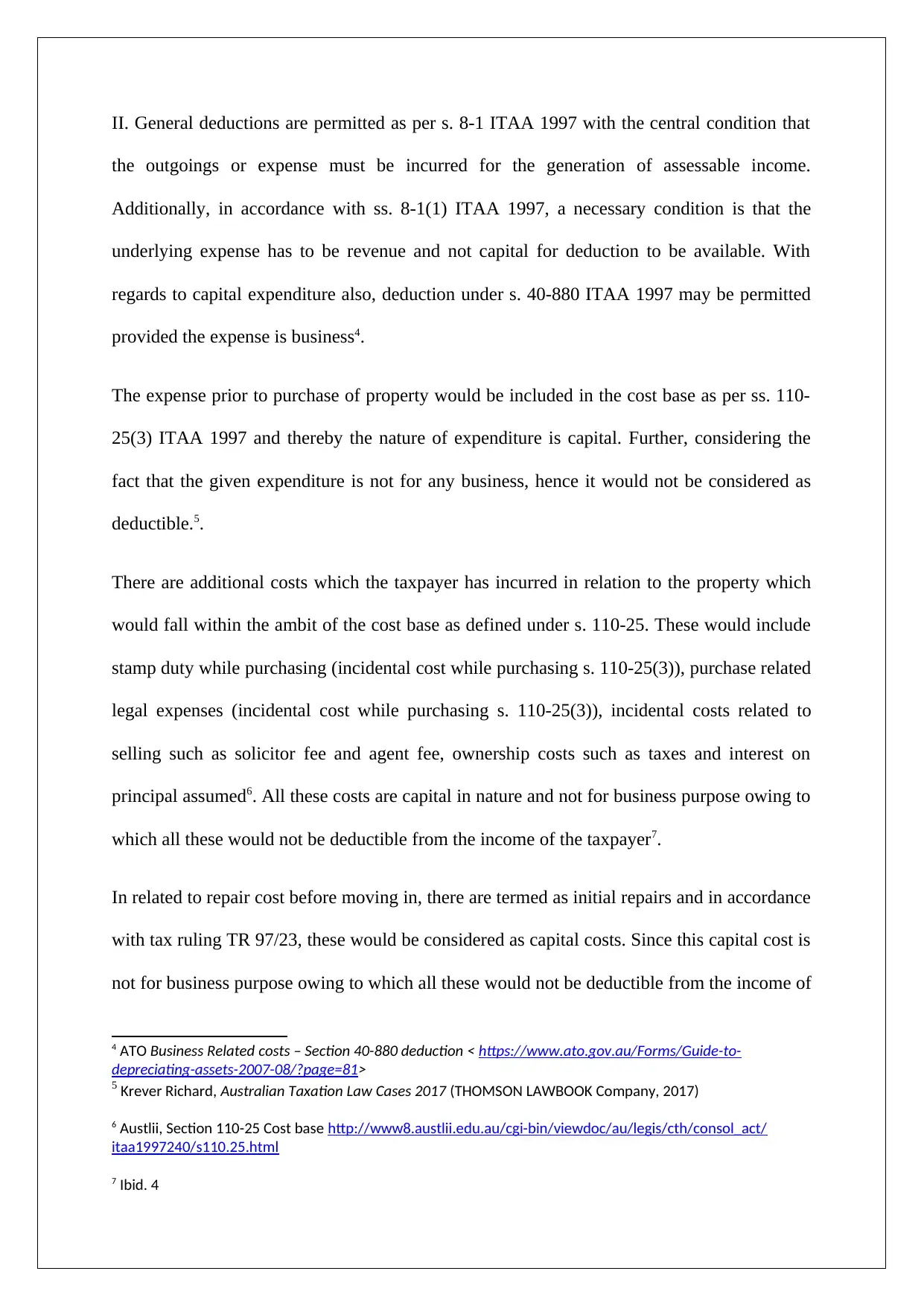
II. General deductions are permitted as per s. 8-1 ITAA 1997 with the central condition that
the outgoings or expense must be incurred for the generation of assessable income.
Additionally, in accordance with ss. 8-1(1) ITAA 1997, a necessary condition is that the
underlying expense has to be revenue and not capital for deduction to be available. With
regards to capital expenditure also, deduction under s. 40-880 ITAA 1997 may be permitted
provided the expense is business4.
The expense prior to purchase of property would be included in the cost base as per ss. 110-
25(3) ITAA 1997 and thereby the nature of expenditure is capital. Further, considering the
fact that the given expenditure is not for any business, hence it would not be considered as
deductible.5.
There are additional costs which the taxpayer has incurred in relation to the property which
would fall within the ambit of the cost base as defined under s. 110-25. These would include
stamp duty while purchasing (incidental cost while purchasing s. 110-25(3)), purchase related
legal expenses (incidental cost while purchasing s. 110-25(3)), incidental costs related to
selling such as solicitor fee and agent fee, ownership costs such as taxes and interest on
principal assumed6. All these costs are capital in nature and not for business purpose owing to
which all these would not be deductible from the income of the taxpayer7.
In related to repair cost before moving in, there are termed as initial repairs and in accordance
with tax ruling TR 97/23, these would be considered as capital costs. Since this capital cost is
not for business purpose owing to which all these would not be deductible from the income of
4 ATO Business Related costs – Section 40-880 deduction < https://www.ato.gov.au/Forms/Guide-to-
depreciating-assets-2007-08/?page=81>
5 Krever Richard, Australian Taxation Law Cases 2017 (THOMSON LAWBOOK Company, 2017)
6 Austlii, Section 110-25 Cost base http://www8.austlii.edu.au/cgi-bin/viewdoc/au/legis/cth/consol_act/
itaa1997240/s110.25.html
7 Ibid. 4
the outgoings or expense must be incurred for the generation of assessable income.
Additionally, in accordance with ss. 8-1(1) ITAA 1997, a necessary condition is that the
underlying expense has to be revenue and not capital for deduction to be available. With
regards to capital expenditure also, deduction under s. 40-880 ITAA 1997 may be permitted
provided the expense is business4.
The expense prior to purchase of property would be included in the cost base as per ss. 110-
25(3) ITAA 1997 and thereby the nature of expenditure is capital. Further, considering the
fact that the given expenditure is not for any business, hence it would not be considered as
deductible.5.
There are additional costs which the taxpayer has incurred in relation to the property which
would fall within the ambit of the cost base as defined under s. 110-25. These would include
stamp duty while purchasing (incidental cost while purchasing s. 110-25(3)), purchase related
legal expenses (incidental cost while purchasing s. 110-25(3)), incidental costs related to
selling such as solicitor fee and agent fee, ownership costs such as taxes and interest on
principal assumed6. All these costs are capital in nature and not for business purpose owing to
which all these would not be deductible from the income of the taxpayer7.
In related to repair cost before moving in, there are termed as initial repairs and in accordance
with tax ruling TR 97/23, these would be considered as capital costs. Since this capital cost is
not for business purpose owing to which all these would not be deductible from the income of
4 ATO Business Related costs – Section 40-880 deduction < https://www.ato.gov.au/Forms/Guide-to-
depreciating-assets-2007-08/?page=81>
5 Krever Richard, Australian Taxation Law Cases 2017 (THOMSON LAWBOOK Company, 2017)
6 Austlii, Section 110-25 Cost base http://www8.austlii.edu.au/cgi-bin/viewdoc/au/legis/cth/consol_act/
itaa1997240/s110.25.html
7 Ibid. 4
⊘ This is a preview!⊘
Do you want full access?
Subscribe today to unlock all pages.

Trusted by 1+ million students worldwide
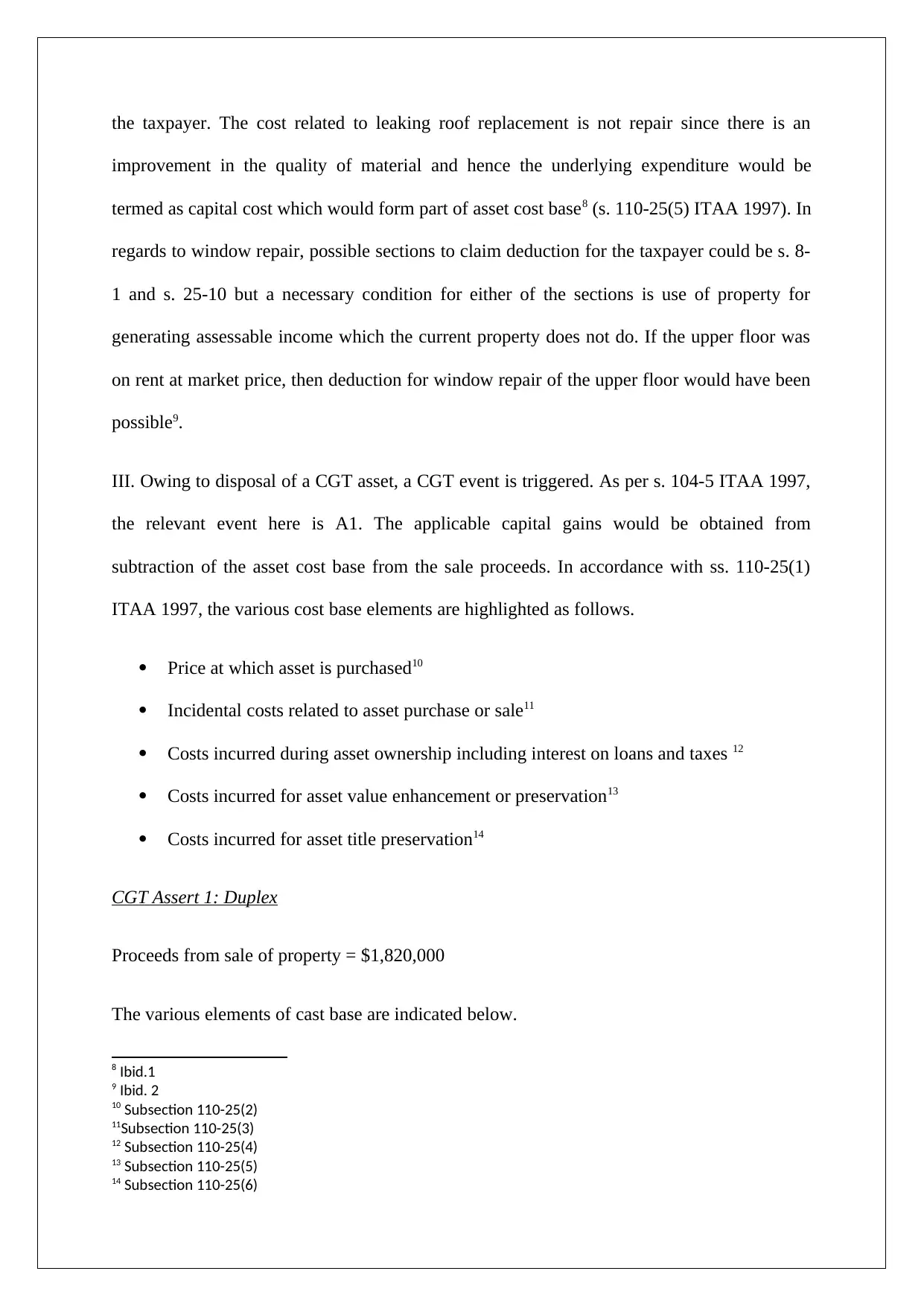
the taxpayer. The cost related to leaking roof replacement is not repair since there is an
improvement in the quality of material and hence the underlying expenditure would be
termed as capital cost which would form part of asset cost base8 (s. 110-25(5) ITAA 1997). In
regards to window repair, possible sections to claim deduction for the taxpayer could be s. 8-
1 and s. 25-10 but a necessary condition for either of the sections is use of property for
generating assessable income which the current property does not do. If the upper floor was
on rent at market price, then deduction for window repair of the upper floor would have been
possible9.
III. Owing to disposal of a CGT asset, a CGT event is triggered. As per s. 104-5 ITAA 1997,
the relevant event here is A1. The applicable capital gains would be obtained from
subtraction of the asset cost base from the sale proceeds. In accordance with ss. 110-25(1)
ITAA 1997, the various cost base elements are highlighted as follows.
Price at which asset is purchased10
Incidental costs related to asset purchase or sale11
Costs incurred during asset ownership including interest on loans and taxes 12
Costs incurred for asset value enhancement or preservation13
Costs incurred for asset title preservation14
CGT Assert 1: Duplex
Proceeds from sale of property = $1,820,000
The various elements of cast base are indicated below.
8 Ibid.1
9 Ibid. 2
10 Subsection 110-25(2)
11Subsection 110-25(3)
12 Subsection 110-25(4)
13 Subsection 110-25(5)
14 Subsection 110-25(6)
improvement in the quality of material and hence the underlying expenditure would be
termed as capital cost which would form part of asset cost base8 (s. 110-25(5) ITAA 1997). In
regards to window repair, possible sections to claim deduction for the taxpayer could be s. 8-
1 and s. 25-10 but a necessary condition for either of the sections is use of property for
generating assessable income which the current property does not do. If the upper floor was
on rent at market price, then deduction for window repair of the upper floor would have been
possible9.
III. Owing to disposal of a CGT asset, a CGT event is triggered. As per s. 104-5 ITAA 1997,
the relevant event here is A1. The applicable capital gains would be obtained from
subtraction of the asset cost base from the sale proceeds. In accordance with ss. 110-25(1)
ITAA 1997, the various cost base elements are highlighted as follows.
Price at which asset is purchased10
Incidental costs related to asset purchase or sale11
Costs incurred during asset ownership including interest on loans and taxes 12
Costs incurred for asset value enhancement or preservation13
Costs incurred for asset title preservation14
CGT Assert 1: Duplex
Proceeds from sale of property = $1,820,000
The various elements of cast base are indicated below.
8 Ibid.1
9 Ibid. 2
10 Subsection 110-25(2)
11Subsection 110-25(3)
12 Subsection 110-25(4)
13 Subsection 110-25(5)
14 Subsection 110-25(6)
Paraphrase This Document
Need a fresh take? Get an instant paraphrase of this document with our AI Paraphraser
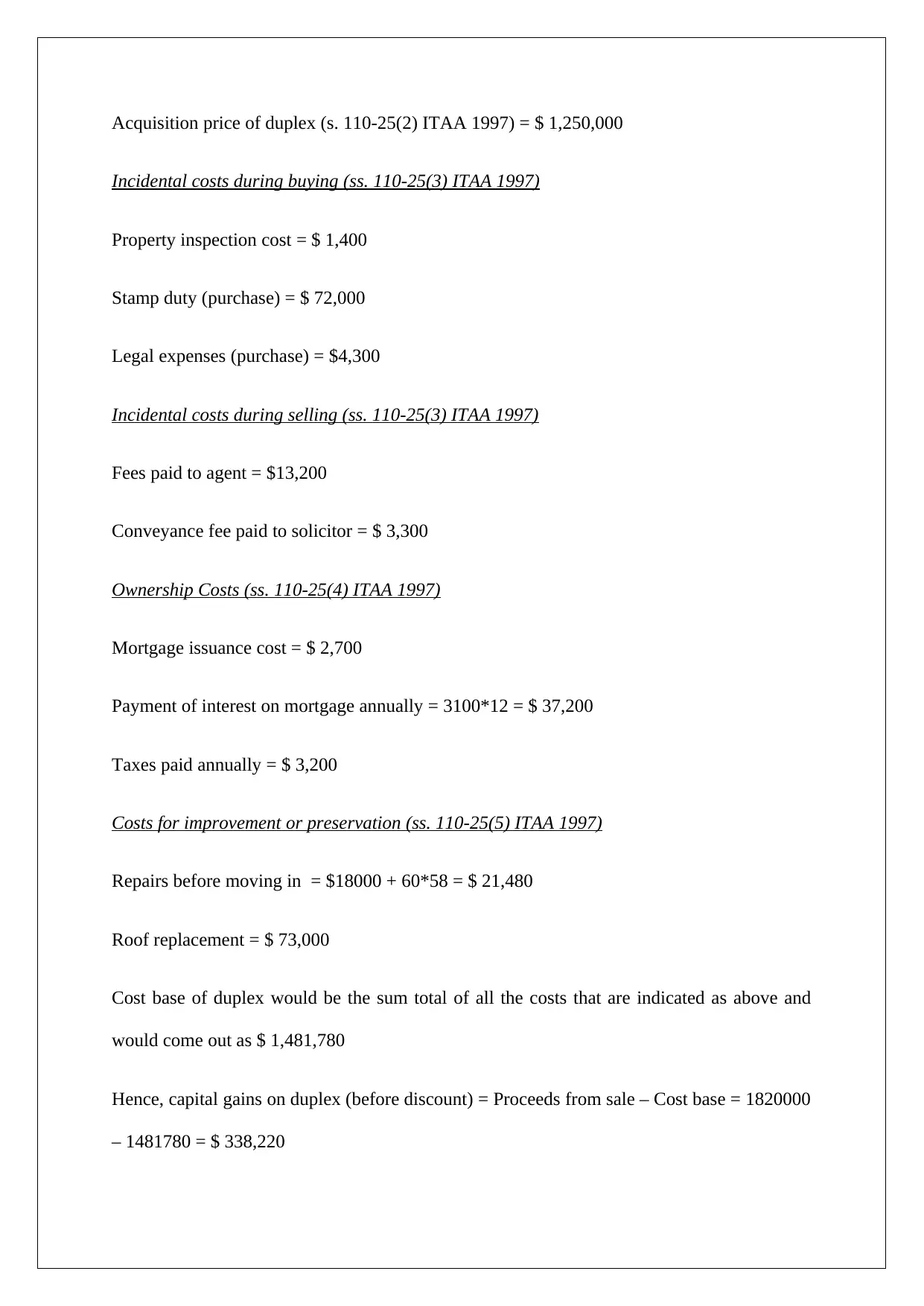
Acquisition price of duplex (s. 110-25(2) ITAA 1997) = $ 1,250,000
Incidental costs during buying (ss. 110-25(3) ITAA 1997)
Property inspection cost = $ 1,400
Stamp duty (purchase) = $ 72,000
Legal expenses (purchase) = $4,300
Incidental costs during selling (ss. 110-25(3) ITAA 1997)
Fees paid to agent = $13,200
Conveyance fee paid to solicitor = $ 3,300
Ownership Costs (ss. 110-25(4) ITAA 1997)
Mortgage issuance cost = $ 2,700
Payment of interest on mortgage annually = 3100*12 = $ 37,200
Taxes paid annually = $ 3,200
Costs for improvement or preservation (ss. 110-25(5) ITAA 1997)
Repairs before moving in = $18000 + 60*58 = $ 21,480
Roof replacement = $ 73,000
Cost base of duplex would be the sum total of all the costs that are indicated as above and
would come out as $ 1,481,780
Hence, capital gains on duplex (before discount) = Proceeds from sale – Cost base = 1820000
– 1481780 = $ 338,220
Incidental costs during buying (ss. 110-25(3) ITAA 1997)
Property inspection cost = $ 1,400
Stamp duty (purchase) = $ 72,000
Legal expenses (purchase) = $4,300
Incidental costs during selling (ss. 110-25(3) ITAA 1997)
Fees paid to agent = $13,200
Conveyance fee paid to solicitor = $ 3,300
Ownership Costs (ss. 110-25(4) ITAA 1997)
Mortgage issuance cost = $ 2,700
Payment of interest on mortgage annually = 3100*12 = $ 37,200
Taxes paid annually = $ 3,200
Costs for improvement or preservation (ss. 110-25(5) ITAA 1997)
Repairs before moving in = $18000 + 60*58 = $ 21,480
Roof replacement = $ 73,000
Cost base of duplex would be the sum total of all the costs that are indicated as above and
would come out as $ 1,481,780
Hence, capital gains on duplex (before discount) = Proceeds from sale – Cost base = 1820000
– 1481780 = $ 338,220
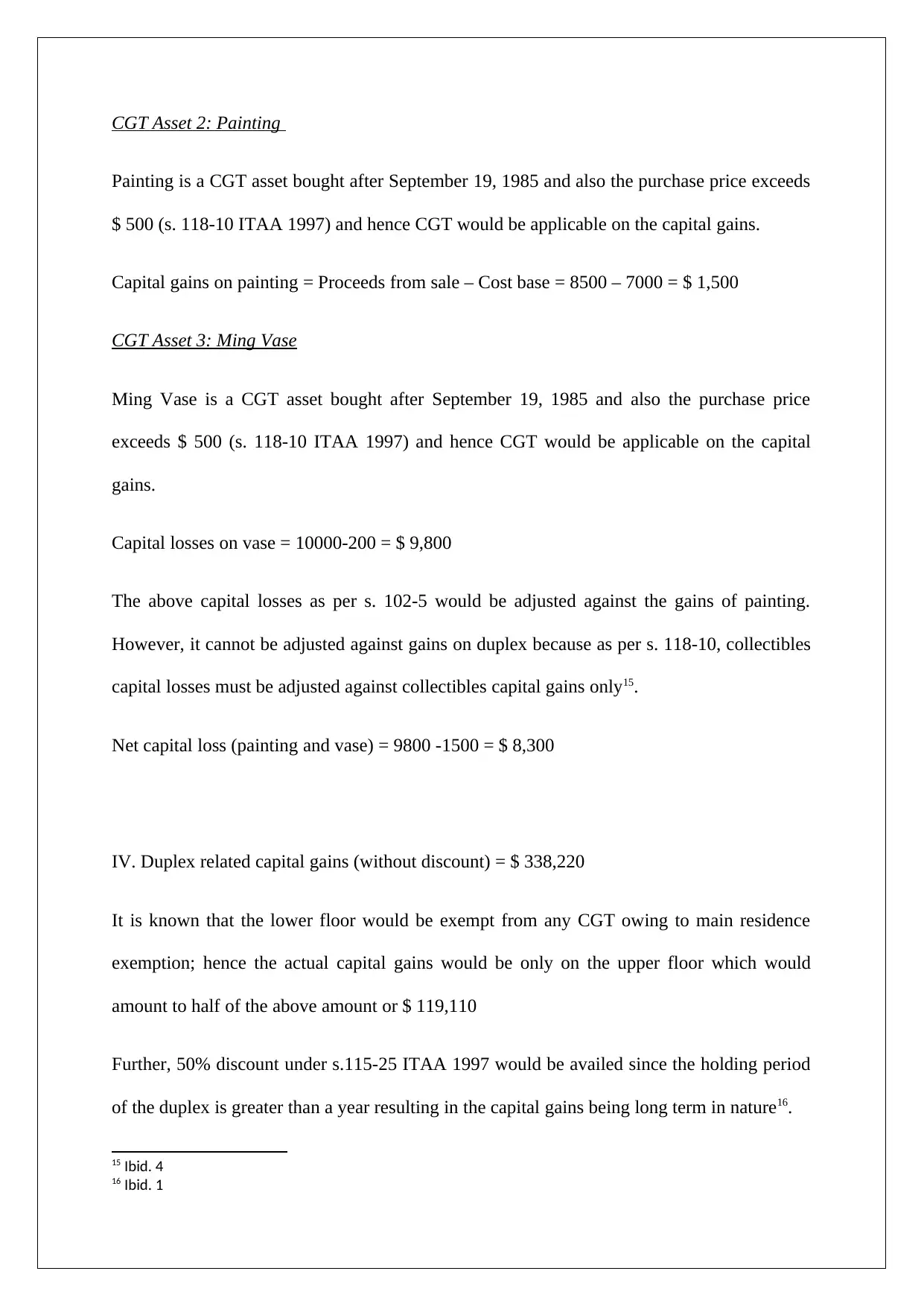
CGT Asset 2: Painting
Painting is a CGT asset bought after September 19, 1985 and also the purchase price exceeds
$ 500 (s. 118-10 ITAA 1997) and hence CGT would be applicable on the capital gains.
Capital gains on painting = Proceeds from sale – Cost base = 8500 – 7000 = $ 1,500
CGT Asset 3: Ming Vase
Ming Vase is a CGT asset bought after September 19, 1985 and also the purchase price
exceeds $ 500 (s. 118-10 ITAA 1997) and hence CGT would be applicable on the capital
gains.
Capital losses on vase = 10000-200 = $ 9,800
The above capital losses as per s. 102-5 would be adjusted against the gains of painting.
However, it cannot be adjusted against gains on duplex because as per s. 118-10, collectibles
capital losses must be adjusted against collectibles capital gains only15.
Net capital loss (painting and vase) = 9800 -1500 = $ 8,300
IV. Duplex related capital gains (without discount) = $ 338,220
It is known that the lower floor would be exempt from any CGT owing to main residence
exemption; hence the actual capital gains would be only on the upper floor which would
amount to half of the above amount or $ 119,110
Further, 50% discount under s.115-25 ITAA 1997 would be availed since the holding period
of the duplex is greater than a year resulting in the capital gains being long term in nature16.
15 Ibid. 4
16 Ibid. 1
Painting is a CGT asset bought after September 19, 1985 and also the purchase price exceeds
$ 500 (s. 118-10 ITAA 1997) and hence CGT would be applicable on the capital gains.
Capital gains on painting = Proceeds from sale – Cost base = 8500 – 7000 = $ 1,500
CGT Asset 3: Ming Vase
Ming Vase is a CGT asset bought after September 19, 1985 and also the purchase price
exceeds $ 500 (s. 118-10 ITAA 1997) and hence CGT would be applicable on the capital
gains.
Capital losses on vase = 10000-200 = $ 9,800
The above capital losses as per s. 102-5 would be adjusted against the gains of painting.
However, it cannot be adjusted against gains on duplex because as per s. 118-10, collectibles
capital losses must be adjusted against collectibles capital gains only15.
Net capital loss (painting and vase) = 9800 -1500 = $ 8,300
IV. Duplex related capital gains (without discount) = $ 338,220
It is known that the lower floor would be exempt from any CGT owing to main residence
exemption; hence the actual capital gains would be only on the upper floor which would
amount to half of the above amount or $ 119,110
Further, 50% discount under s.115-25 ITAA 1997 would be availed since the holding period
of the duplex is greater than a year resulting in the capital gains being long term in nature16.
15 Ibid. 4
16 Ibid. 1
⊘ This is a preview!⊘
Do you want full access?
Subscribe today to unlock all pages.

Trusted by 1+ million students worldwide
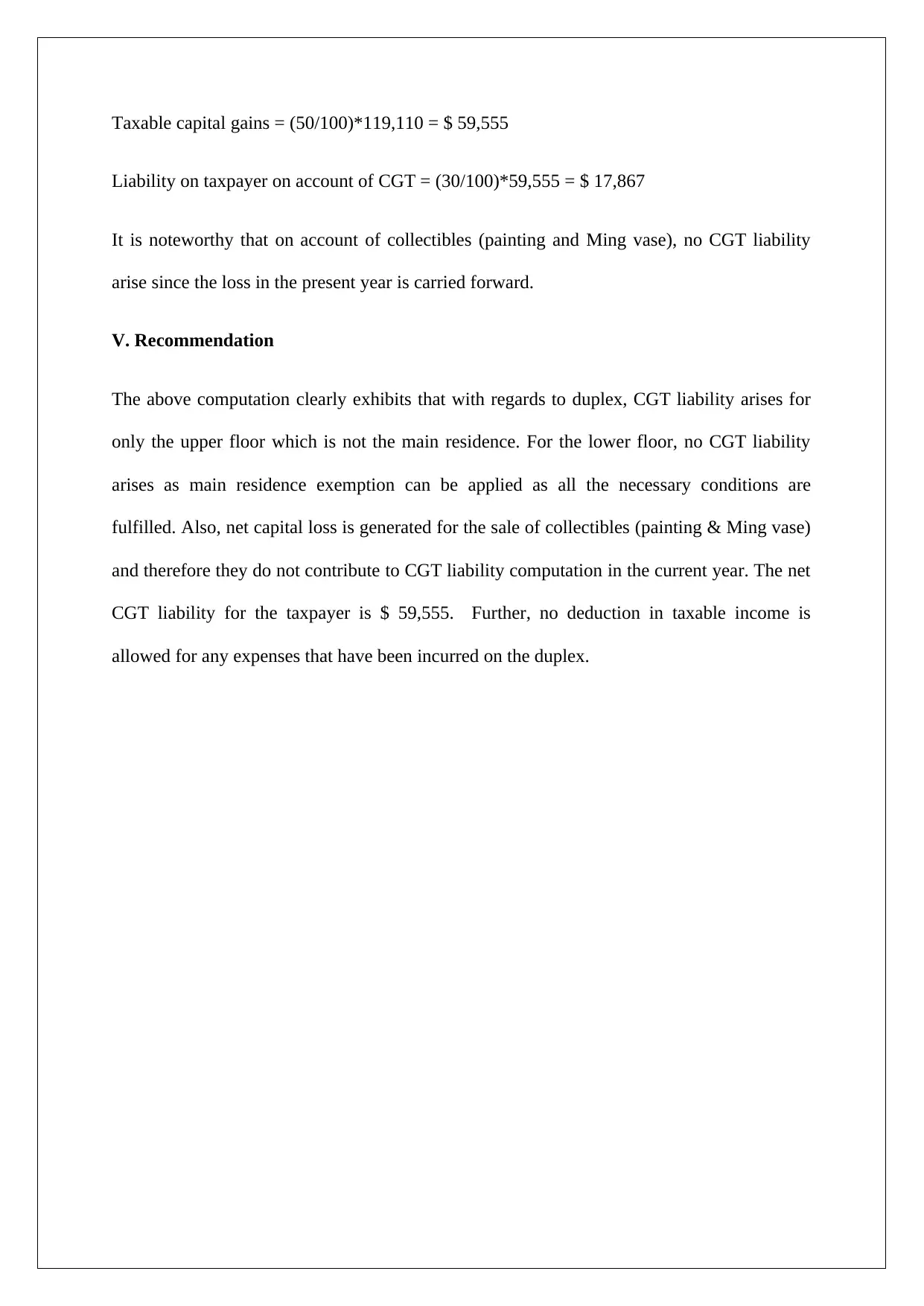
Taxable capital gains = (50/100)*119,110 = $ 59,555
Liability on taxpayer on account of CGT = (30/100)*59,555 = $ 17,867
It is noteworthy that on account of collectibles (painting and Ming vase), no CGT liability
arise since the loss in the present year is carried forward.
V. Recommendation
The above computation clearly exhibits that with regards to duplex, CGT liability arises for
only the upper floor which is not the main residence. For the lower floor, no CGT liability
arises as main residence exemption can be applied as all the necessary conditions are
fulfilled. Also, net capital loss is generated for the sale of collectibles (painting & Ming vase)
and therefore they do not contribute to CGT liability computation in the current year. The net
CGT liability for the taxpayer is $ 59,555. Further, no deduction in taxable income is
allowed for any expenses that have been incurred on the duplex.
Liability on taxpayer on account of CGT = (30/100)*59,555 = $ 17,867
It is noteworthy that on account of collectibles (painting and Ming vase), no CGT liability
arise since the loss in the present year is carried forward.
V. Recommendation
The above computation clearly exhibits that with regards to duplex, CGT liability arises for
only the upper floor which is not the main residence. For the lower floor, no CGT liability
arises as main residence exemption can be applied as all the necessary conditions are
fulfilled. Also, net capital loss is generated for the sale of collectibles (painting & Ming vase)
and therefore they do not contribute to CGT liability computation in the current year. The net
CGT liability for the taxpayer is $ 59,555. Further, no deduction in taxable income is
allowed for any expenses that have been incurred on the duplex.
1 out of 7
Related Documents
Your All-in-One AI-Powered Toolkit for Academic Success.
+13062052269
info@desklib.com
Available 24*7 on WhatsApp / Email
![[object Object]](/_next/static/media/star-bottom.7253800d.svg)
Unlock your academic potential
Copyright © 2020–2025 A2Z Services. All Rights Reserved. Developed and managed by ZUCOL.





